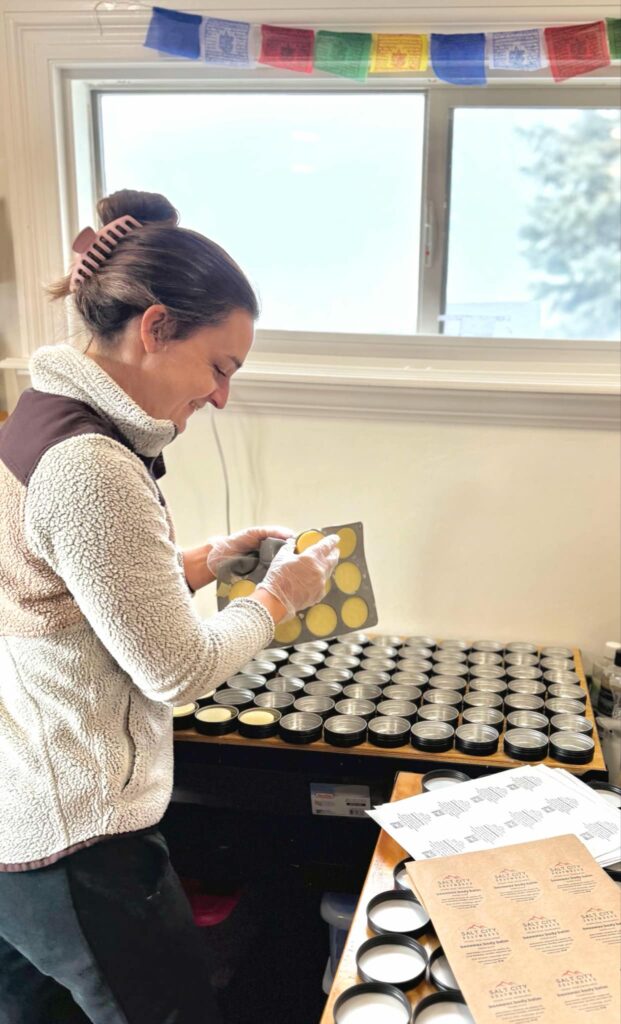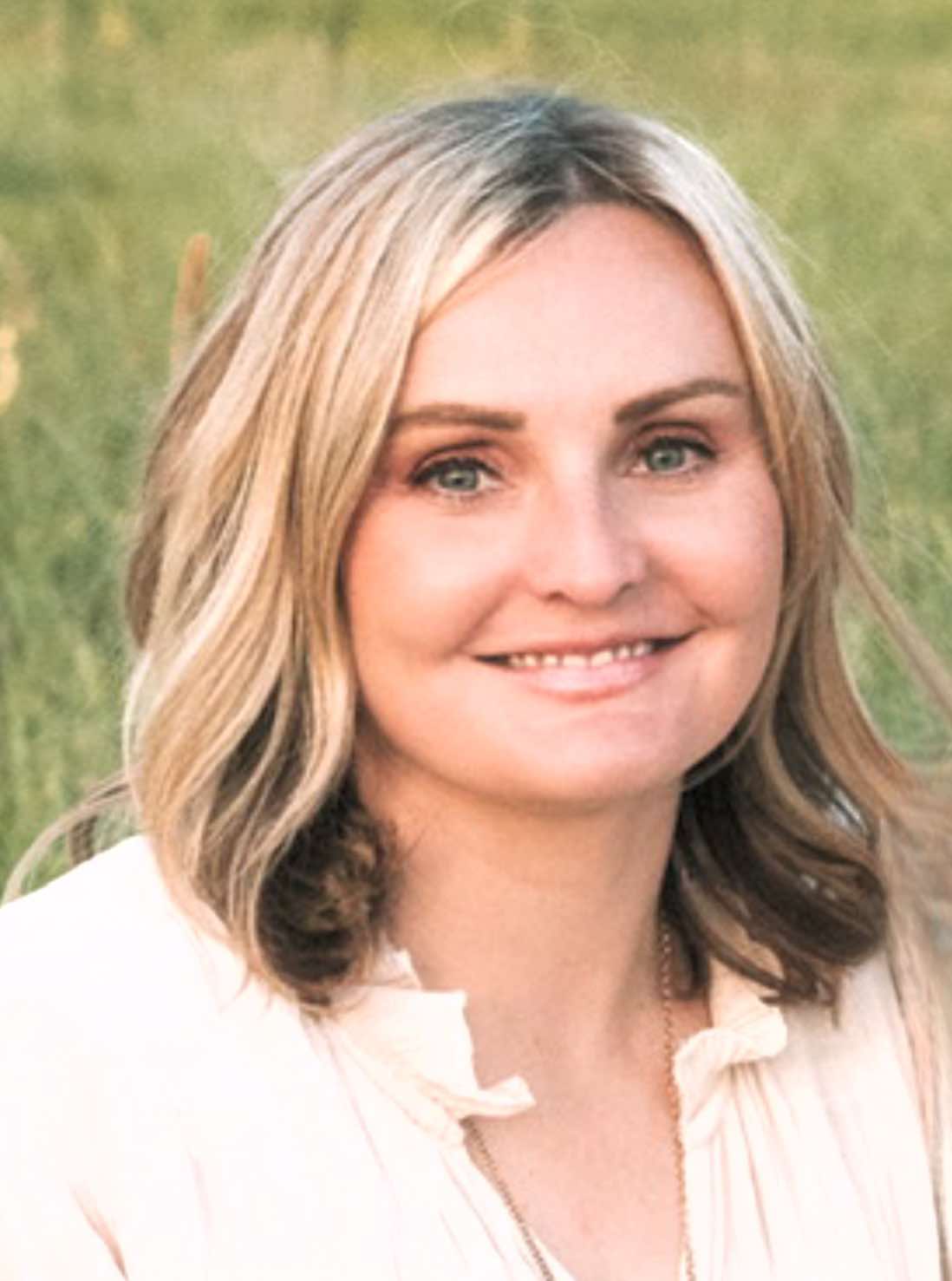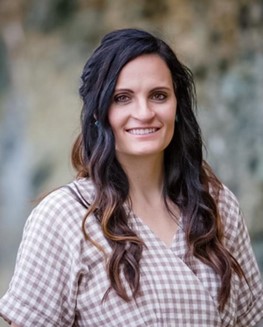Lauren Tyson, founder of Salt City Soapworks, became seriously ill after the birth of her fourth child ten years ago. When doctors couldn’t find answers to help her, she dove into research on how food and mindset influence overall health. She began changing her eating habits and shopping choices and understanding the importance of using skincare products with all-natural ingredients. Over the next two years, Lauren steadily improved and regained good health. Lauren notes, “Our skin is the largest organ in our body, and it absorbs whatever we apply to it.”
Lauren’s background in geology and passion for health led her to make her own line of skincare products. She uses a local natural resource—unrefined salt from Redmond, Utah, which is known for its high mineral content and detoxifying properties. “The salt was deposited around the time of the dinosaurs, which is really cool, and it contains over 60 essential minerals,” she says. Combining the salt with coconut oil created the foundation for her exfoliating, skin-nourishing salt soap recipes. This blend became the cornerstone of Salt City Soapworks, a family-run business rooted in community and environmental values.
Here are some key lessons Lauren has learned for anyone looking to start a soap and skincare business.
1. Allow Time for Research and Development
Soapmaking is a scientific process, and Lauren emphasizes the importance of getting the chemistry right. “It took almost two years to perfect my recipes,” she says. Adding salt alters the chemical composition, making the process more complex. “The salt makes the soap brittle, making cutting or removing it from molds difficult. Even a slight mistake with timing or temperature can ruin the batch.”
Lauren is meticulous about every step in the process. She measures everything down to the gram and keeps notes on what works and what doesn’t. “Scent development was a whole other challenge,” she admits. “I spent a lot of time experimenting to find natural and pleasing scents that appeal to many customers.”
She stresses the importance of patience and research. “You really need time to perfect your recipes and make sure they’re exactly what you want because your passion, or lack thereof, comes through when you sell your products.”

2. Perfect Your Craft
Lauren uses the cold-process method for soap making, which requires precise attention to detail, particularly regarding temperature control. “The first step is to mix lye with water. The mixture heats up naturally, so you have to wait for it to cool to the correct temperature,” she explains. In the meantime, she melts her oils and allows them to cool to the same temperature as the lye solution.
Once they reach the perfect temperature, Lauren mixes the lye and oils with an immersion blender. This process starts the chemical reaction of saponification: turning the oils and lye into soap. “If the mixture is too hot, it will burn off the essential oils, which will ruin the batch,” Lauren says.
After blending, the soap is poured into molds and allowed to set. “When the soap is firm but not too hard, I cut and stamp each bar.” Technically, the soap can be used after 24 hours, but Lauren lets the mixture cure for at least three weeks for a harder, longer-lasting bar. “It’s all about timing,” she says.
The process is more straightforward for lotion bars and lip balms but still requires precision. “It’s a bit of a mad dash to get everything into molds before it sets,” Lauren explains. “You’ve got to work quickly to get the consistency just right.”
3. Focus on Quality and Transparency
Lauren is committed to using only simple, eco-friendly ingredients that are safe to wash down the drain. “I won’t use anything I can’t verify as real and natural,” she says. She colors her soaps with natural ingredients like kaolin clay, charcoal, and oxides.
Her dedication to sourcing high-quality ingredients stems from an incident she experienced before starting her business when she ordered what was supposedly 100% organic beeswax from an online supplier. “I opened the box and was hit with a whoosh of petroleum odor. The beeswax was the same color as processed cheese,” she recalls. As a beekeeper, she immediately recognized that the product wasn’t authentic and wondered how many others would have been fooled by the imitation beeswax.
“I went online to return it and asked about their quality control procedures for sellers. That’s when I realized there were no checks and balances,” she adds. This eye-opening realization strengthened her commitment to sourcing ingredients she can personally verify and trust. “I also make sure to source my beeswax from local suppliers.”
She is also mindful of packaging materials. “Packaging is part of the ingredients,” she points out. “I try to minimize waste by stamping labels directly on the soap and using tin and glass containers that can be reused.” She wants to assure her customers that the ingredients in Salt City Soapworks are beneficial for their skin and safe for the environment.
4. Launch Your Products by Starting Small
Lauren’s marketing approach has always been organic and cost-effective. “The best thing about starting small is that you get to learn cheap and learn fast,” she explains. “It’s a low-risk way to figure out what works and what doesn’t.”
She built Salt City Soapworks by relying on word-of-mouth, repeat customers, craft fairs, and Christmas markets. She runs her website on Shopify and engages with customers through social media platforms like Facebook and Instagram. “I try to use social media to share what we’re doing, why we do it, and how our products are different.” Lauren also stays away from high-fee platforms like Etsy. “The fees eat into your margins. I’d rather keep the prices affordable for customers without compromising on quality.”
5. Keep Learning and Adapting
Lauren’s scientific education laid a foundation for developing her products, but she continually seeks to broaden her knowledge. She’s currently enrolled in the Master of Business Creation program at the University of Utah. “I want to learn as much as I can,” she says. “Understanding how to structure my business is just as important as the products themselves.”
She also gathers valuable insights into her product line by engaging with her customers to learn what they love and want from her products. This feedback serves as inspiration for new ideas. She shares, “Recently, a friend mentioned how much she enjoys using our salt scrubs on her face. It got me thinking about creating an unscented charcoal salt scrub specifically for the face. I haven’t had a chance to make it yet, but I’m excited to see if it might help with acne.” Another time, a customer requested an exfoliating soap. Lauren added finely ground pumice stone and coffee grounds to her soap to create a gentle, non-abrasive exfoliant that is safe for sensitive skin. Engaging with her customers helps her refine her offerings to fit their needs.
6. Stay True to Your Business Goals and Values
Lauren’s values form the foundation of her business’s success. “It would be easy to churn out higher profits by using cheaper ingredients, but I’m not even tempted. That’s just not who I am,” she says. Her passion for Salt City Soapworks motivates her to stay stubbornly focused on her vision, while her commitment to remaining true to her values fosters creativity.
She emphasizes that people should be curious about the things they put on their skin. While Lauren’s customers have come to trust her advice and judgment, she states, “I would like to take it a step further by providing documentation so they don’t have to rely on my word. I also want to educate them about the benefits of our products and raise awareness about the dangers of preservatives and chemicals used as stabilizers in commercial skincare.”
She says the best part of her work is hearing from satisfied customers. “There’s nothing better than someone telling me they love a product I’ve made and that they appreciate the time and care that went into it.” Through persistence, research, and staying true to her values, Lauren transformed her health and created a business that helps others.


